Procurement 101: Supplier Onboarding – A process often overlooked but crucial to competitiveness
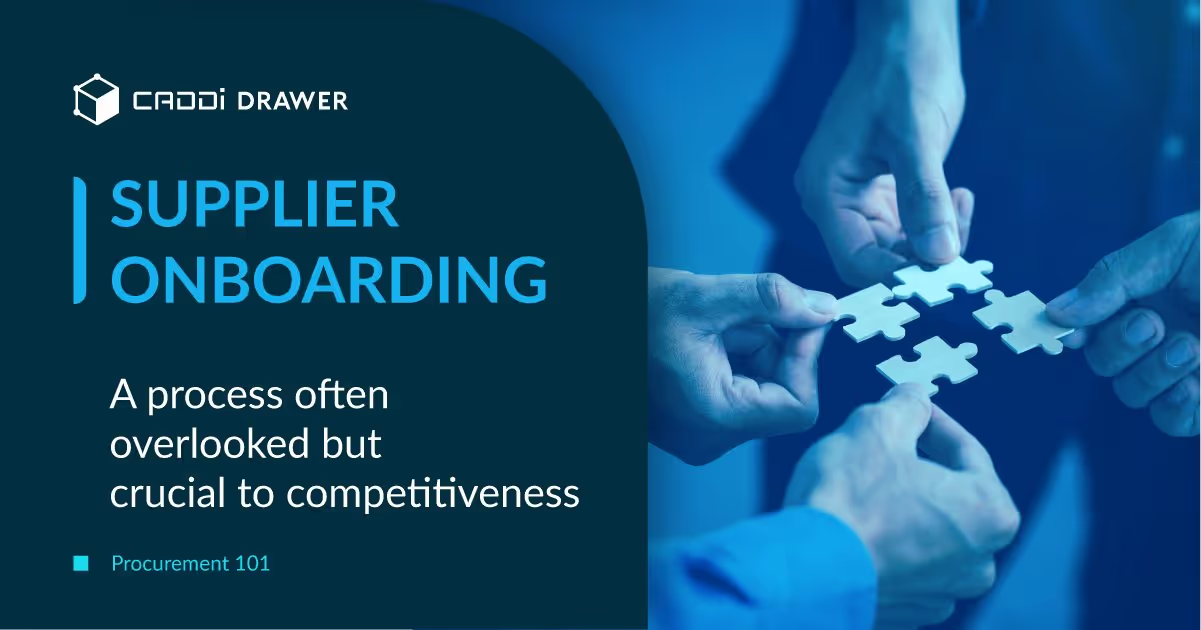
Table of Contents

Supplier onboarding is the process through which new suppliers are integrated into an organization’s procurement and operational frameworks. It encompasses a series of steps aimed at ensuring that suppliers meet the company’s compliance, quality, and performance standards. This process is pivotal in manufacturing, where the reliance on a multitude of suppliers for materials, components, and services is a given. The efficiency, reliability, and quality of these suppliers directly influence production lines, product quality, and market responsiveness.
Value of Effective Supplier Onboarding
Supplier onboarding is an indispensable process in the manufacturing sector. A meticulously designed onboarding process ensures that suppliers are perfectly in sync with a company’s standards for compliance, quality, and operations right from the beginning.
This alignment is crucial for accelerating product delivery to market, elevating product quality, and enhancing the company’s ability to swiftly adapt to changes in market demands. A case in point is a multinational corporation that transformed its supplier onboarding process, incorporating stringent compliance verifications and performance metrics. This overhaul not only expedited the incorporation of new suppliers but also boosted production efficiency by 30% and slashed compliance-related issues by 40%, underscoring the critical advantages of a well-structured supplier onboarding program.
What if you don’t conduct supplier onboarding effectively?
Without an effective supplier onboarding strategy, manufacturers expose themselves to escalated risks and disruptions that can result in significant financial losses and erode their market position and competitiveness in the medium to long term.
Neglecting thorough supplier onboarding can lead to a cascade of adverse effects, including diminished production efficiency and compromised product quality. Moreover, the time and effort invested in supplier development end up being wasted. Such oversights can culminate in costly delays, legal penalties, limited collaboration with suppliers, and low retention rate of suppliers. As a result, the performance of quality, cost, and delivery gradually deteriorates without realizing that.
Key Steps in the Supplier Onboarding Process
Here are the specific steps to successfully execute supplier onboarding.
1. Setting Criteria and Metrics to Measure the Progress of Onboarding
Integrating specific criteria and metrics like on-time delivery rate, acknowledgment rate, and responsiveness into supplier onboarding processes is crucial for aligning with business goals, assessing supplier performance, and fostering beneficial relationships.
Utilizing supplier scorecards effectively tracks these metrics, aiding in vendor management, enhancing communication, and facilitating data-driven decisions to optimize the supplier onboarding process.
2. Clear Communication of Expectations and Requirements
Successful onboarding starts with clear communication. Manufacturers need to articulate their expectations, quality standards, delivery schedules, and compliance requirements. This step often includes providing detailed documentation and guidelines to the suppliers.
To ensure that initial communication from buyers to suppliers does not vary, the content and method of explanation should be standardized. Of course, what needs to be communicated will change depending on the item, so it would be wise to categorize items within some framework and then standardize the content of explanations by category.
3. Streamlined Documentation and Data Management
Collecting and managing critical supplier documents, such as contracts, tax information, and certification of compliance, is essential. Utilizing digital solutions for document management can greatly enhance efficiency and reduce errors.
4. Integration into Procurement and Operational Systems
Suppliers should be integrated into the manufacturer’s procurement and operational systems, including order management, inventory systems, and payment processes. This integration is crucial for seamless transactions and real-time tracking.
5. Compliance and Quality Assurance Checks
Implementing rigorous compliance and quality checks during the onboarding process is critical. This might include site visits, sample product evaluations, and validation of compliance with relevant regulations and standards.
6. Training and Development
Providing training to suppliers on the company’s processes, systems, and expectations is crucial for a smooth partnership. This might include training on using the company’s procurement platform, quality standards, and reporting requirements.
7. Continuous Performance Monitoring and Feedback
Effective onboarding doesn’t end with the initial setup. Continuous monitoring of supplier performance and providing regular feedback are vital for maintaining high standards and fostering improvement.
Evaluating suppliers through the production of sample items or a limited range of products is common and essential. However, it is questionable whether assessing suppliers based solely on the finished product is sufficient. They might have submitted a few of their best products after numerous failed attempts. Therefore, it is recommended not just to focus on the results but also to monitor alongside the production process.
Considerations Throughout the Entire Process
One important point to note here is that new suppliers often do not know what they do not understand. Therefore, even if you ask suppliers if they have any questions, they might not ask anything because they don’t know what they should be asking. At this stage, the lack of questions could indicate not that the suppliers understand everything sufficiently, but rather that they might not understand much at all.
Also, what is considered common knowledge on the buyer’s side may not necessarily be so for new suppliers. buyers should not assume that “they must naturally know this, so there’s no need to include it in explanations or training.” Skipping explanations could lead to problems later on. Even if it takes more time, the onboarding process should comprehensively cover basic assumptions and finer details.
Overcoming Supplier Onboarding Challenges
The process of integrating new suppliers into an organization’s operations, despite technological advances, faces several challenges. Here’s how companies are navigating these issues to improve efficiency and supplier relationships.
Data Quality and Standardization Issues
Challenge: Companies often struggle with poor data quality and a lack of standardization across departments, complicating the onboarding process.
Solution: Implementing supplier portals offers a centralized platform for data entry and access, which enhances data accuracy and consistency. This approach simplifies the integration of new suppliers, ensuring that data quality issues do not hinder the onboarding process. Sharing failure cases and lessons learned in supplier onboarding is also an effective approach.
Compliance Management Across Global Supply Chains
Challenge: Managing compliance across global supply chains is a daunting task, made more complex by varying international standards and regulations.
Solution: Standardized procedures and checklists ensure compliance requirements are met consistently across all regions. This method reduces the risk of compliance-related issues and streamlines the onboarding process for suppliers from different parts of the world.
Communication Barriers
Challenge: Internal and external communication barriers can lead to delays and inefficiencies in the onboarding process.
Solution: Technology solutions that facilitate real-time communication and collaboration are critical. For instance, cloud-based vendor management systems enable stakeholders to update and collaborate in real time, significantly reducing onboarding time and improving supplier performance metrics.
How CADDi Drawer supports reverse auctions
CADDi Drawer is not a supplier management system, but it is one of the solutions for these challenges. It automatically links and aggregates design data, procurement data, and supplier information for each drawing, makes them searchable, and can also produce outputs tied to the drawings.
Similarity search of part drawings
The similarity search feature allows for the instant identification of items similar in type or shape to those being considered for reverse auctions from a vast collection of drawings. This feature allows for the tracking of performance and past issues of existing suppliers in the production of parts similar to those being ordered from new suppliers.
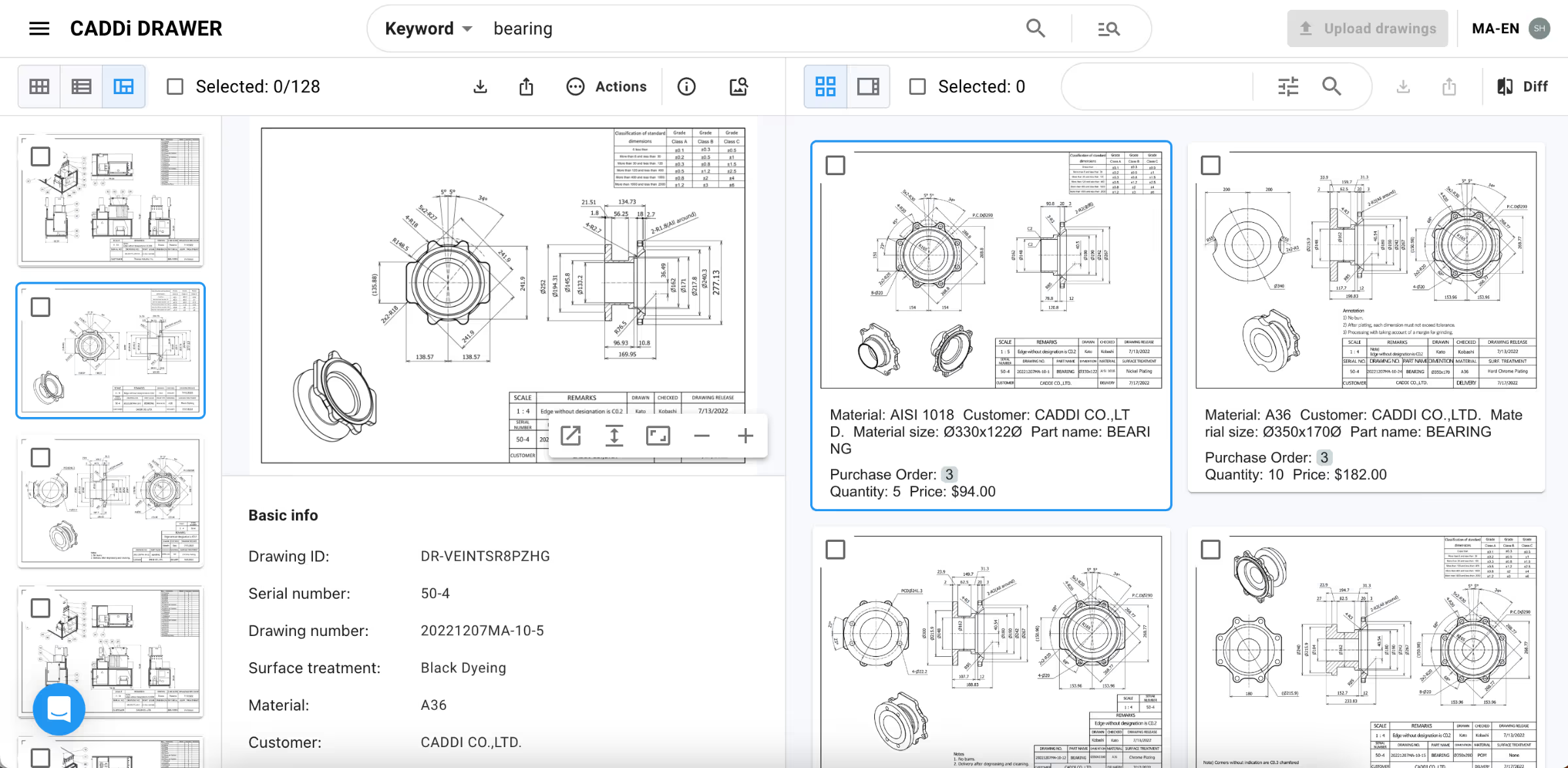
Streamline activities in the procurement process
The following features enable you to streamline the time-consuming tasks of data collection and organization in procurement operations. They serve as support for monitoring the progress of supplier onboarding.
- Price data and supplier information can be automatically linked to each drawing and can also be exported together.
- By using keyword searches combined with similarity searches, the time spent searching for drawings and data in procurement tasks can be reduced.
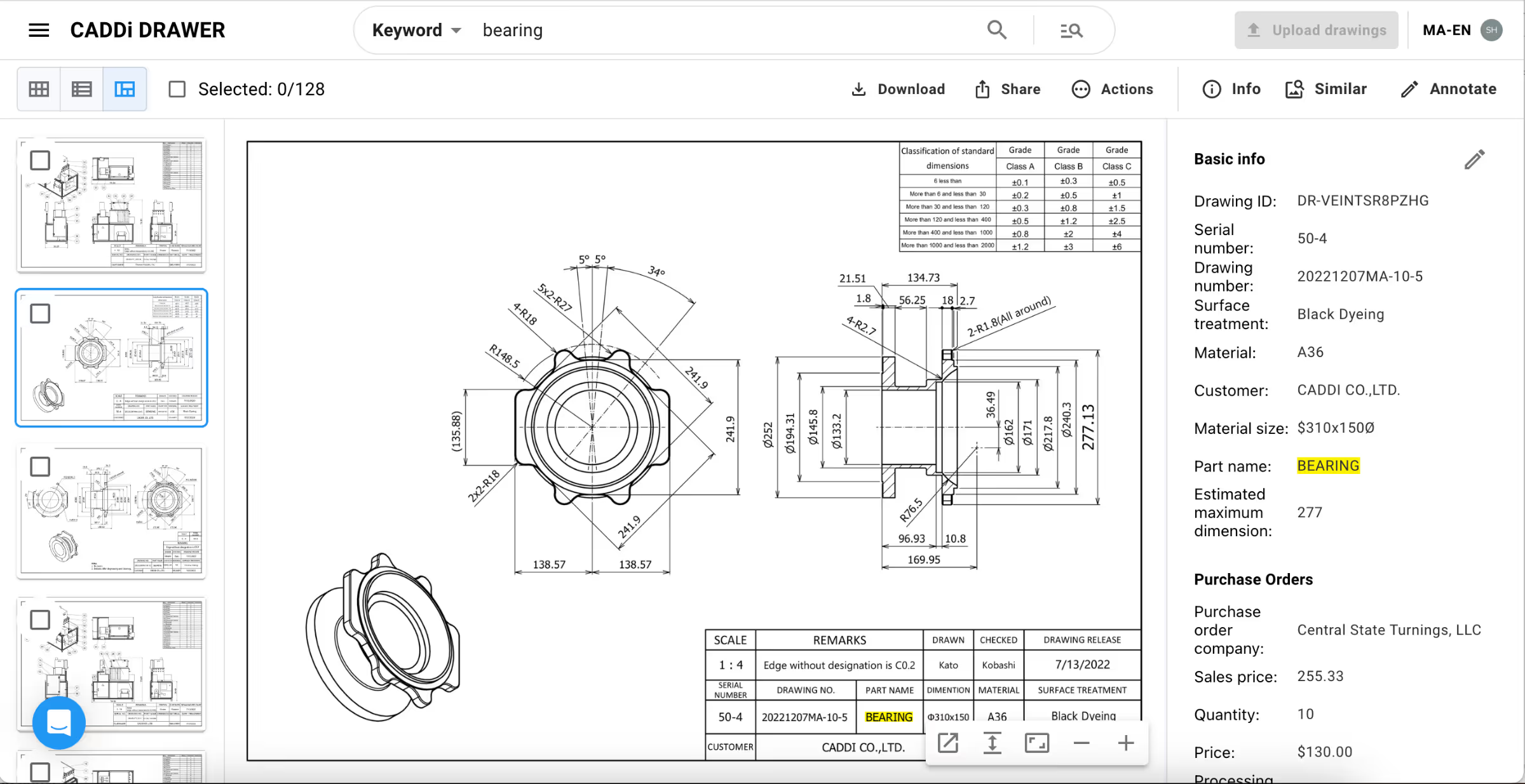
Supplier onboarding is the process through which new suppliers are integrated into an organization’s procurement and operational frameworks. It encompasses a series of steps aimed at ensuring that suppliers meet the company’s compliance, quality, and performance standards. This process is pivotal in manufacturing, where the reliance on a multitude of suppliers for materials, components, and services is a given. The efficiency, reliability, and quality of these suppliers directly influence production lines, product quality, and market responsiveness.
Value of Effective Supplier Onboarding
Supplier onboarding is an indispensable process in the manufacturing sector. A meticulously designed onboarding process ensures that suppliers are perfectly in sync with a company’s standards for compliance, quality, and operations right from the beginning.
This alignment is crucial for accelerating product delivery to market, elevating product quality, and enhancing the company’s ability to swiftly adapt to changes in market demands. A case in point is a multinational corporation that transformed its supplier onboarding process, incorporating stringent compliance verifications and performance metrics. This overhaul not only expedited the incorporation of new suppliers but also boosted production efficiency by 30% and slashed compliance-related issues by 40%, underscoring the critical advantages of a well-structured supplier onboarding program.
What if you don’t conduct supplier onboarding effectively?
Without an effective supplier onboarding strategy, manufacturers expose themselves to escalated risks and disruptions that can result in significant financial losses and erode their market position and competitiveness in the medium to long term.
Neglecting thorough supplier onboarding can lead to a cascade of adverse effects, including diminished production efficiency and compromised product quality. Moreover, the time and effort invested in supplier development end up being wasted. Such oversights can culminate in costly delays, legal penalties, limited collaboration with suppliers, and low retention rate of suppliers. As a result, the performance of quality, cost, and delivery gradually deteriorates without realizing that.
Key Steps in the Supplier Onboarding Process
Here are the specific steps to successfully execute supplier onboarding.
1. Setting Criteria and Metrics to Measure the Progress of Onboarding
Integrating specific criteria and metrics like on-time delivery rate, acknowledgment rate, and responsiveness into supplier onboarding processes is crucial for aligning with business goals, assessing supplier performance, and fostering beneficial relationships.
Utilizing supplier scorecards effectively tracks these metrics, aiding in vendor management, enhancing communication, and facilitating data-driven decisions to optimize the supplier onboarding process.
2. Clear Communication of Expectations and Requirements
Successful onboarding starts with clear communication. Manufacturers need to articulate their expectations, quality standards, delivery schedules, and compliance requirements. This step often includes providing detailed documentation and guidelines to the suppliers.
To ensure that initial communication from buyers to suppliers does not vary, the content and method of explanation should be standardized. Of course, what needs to be communicated will change depending on the item, so it would be wise to categorize items within some framework and then standardize the content of explanations by category.
3. Streamlined Documentation and Data Management
Collecting and managing critical supplier documents, such as contracts, tax information, and certification of compliance, is essential. Utilizing digital solutions for document management can greatly enhance efficiency and reduce errors.
4. Integration into Procurement and Operational Systems
Suppliers should be integrated into the manufacturer’s procurement and operational systems, including order management, inventory systems, and payment processes. This integration is crucial for seamless transactions and real-time tracking.
5. Compliance and Quality Assurance Checks
Implementing rigorous compliance and quality checks during the onboarding process is critical. This might include site visits, sample product evaluations, and validation of compliance with relevant regulations and standards.
6. Training and Development
Providing training to suppliers on the company’s processes, systems, and expectations is crucial for a smooth partnership. This might include training on using the company’s procurement platform, quality standards, and reporting requirements.
7. Continuous Performance Monitoring and Feedback
Effective onboarding doesn’t end with the initial setup. Continuous monitoring of supplier performance and providing regular feedback are vital for maintaining high standards and fostering improvement.
Evaluating suppliers through the production of sample items or a limited range of products is common and essential. However, it is questionable whether assessing suppliers based solely on the finished product is sufficient. They might have submitted a few of their best products after numerous failed attempts. Therefore, it is recommended not just to focus on the results but also to monitor alongside the production process.
Considerations Throughout the Entire Process
One important point to note here is that new suppliers often do not know what they do not understand. Therefore, even if you ask suppliers if they have any questions, they might not ask anything because they don’t know what they should be asking. At this stage, the lack of questions could indicate not that the suppliers understand everything sufficiently, but rather that they might not understand much at all.
Also, what is considered common knowledge on the buyer’s side may not necessarily be so for new suppliers. buyers should not assume that “they must naturally know this, so there’s no need to include it in explanations or training.” Skipping explanations could lead to problems later on. Even if it takes more time, the onboarding process should comprehensively cover basic assumptions and finer details.
Overcoming Supplier Onboarding Challenges
The process of integrating new suppliers into an organization’s operations, despite technological advances, faces several challenges. Here’s how companies are navigating these issues to improve efficiency and supplier relationships.
Data Quality and Standardization Issues
Challenge: Companies often struggle with poor data quality and a lack of standardization across departments, complicating the onboarding process.
Solution: Implementing supplier portals offers a centralized platform for data entry and access, which enhances data accuracy and consistency. This approach simplifies the integration of new suppliers, ensuring that data quality issues do not hinder the onboarding process. Sharing failure cases and lessons learned in supplier onboarding is also an effective approach.
Compliance Management Across Global Supply Chains
Challenge: Managing compliance across global supply chains is a daunting task, made more complex by varying international standards and regulations.
Solution: Standardized procedures and checklists ensure compliance requirements are met consistently across all regions. This method reduces the risk of compliance-related issues and streamlines the onboarding process for suppliers from different parts of the world.
Communication Barriers
Challenge: Internal and external communication barriers can lead to delays and inefficiencies in the onboarding process.
Solution: Technology solutions that facilitate real-time communication and collaboration are critical. For instance, cloud-based vendor management systems enable stakeholders to update and collaborate in real time, significantly reducing onboarding time and improving supplier performance metrics.
How CADDi Drawer supports reverse auctions
CADDi Drawer is not a supplier management system, but it is one of the solutions for these challenges. It automatically links and aggregates design data, procurement data, and supplier information for each drawing, makes them searchable, and can also produce outputs tied to the drawings.
Similarity search of part drawings
The similarity search feature allows for the instant identification of items similar in type or shape to those being considered for reverse auctions from a vast collection of drawings. This feature allows for the tracking of performance and past issues of existing suppliers in the production of parts similar to those being ordered from new suppliers.

Streamline activities in the procurement process
The following features enable you to streamline the time-consuming tasks of data collection and organization in procurement operations. They serve as support for monitoring the progress of supplier onboarding.
- Price data and supplier information can be automatically linked to each drawing and can also be exported together.
- By using keyword searches combined with similarity searches, the time spent searching for drawings and data in procurement tasks can be reduced.

Ready to see CADDi Drawer in action? Get a personalized demo.
Subscribe to our Blog!
Related Resources


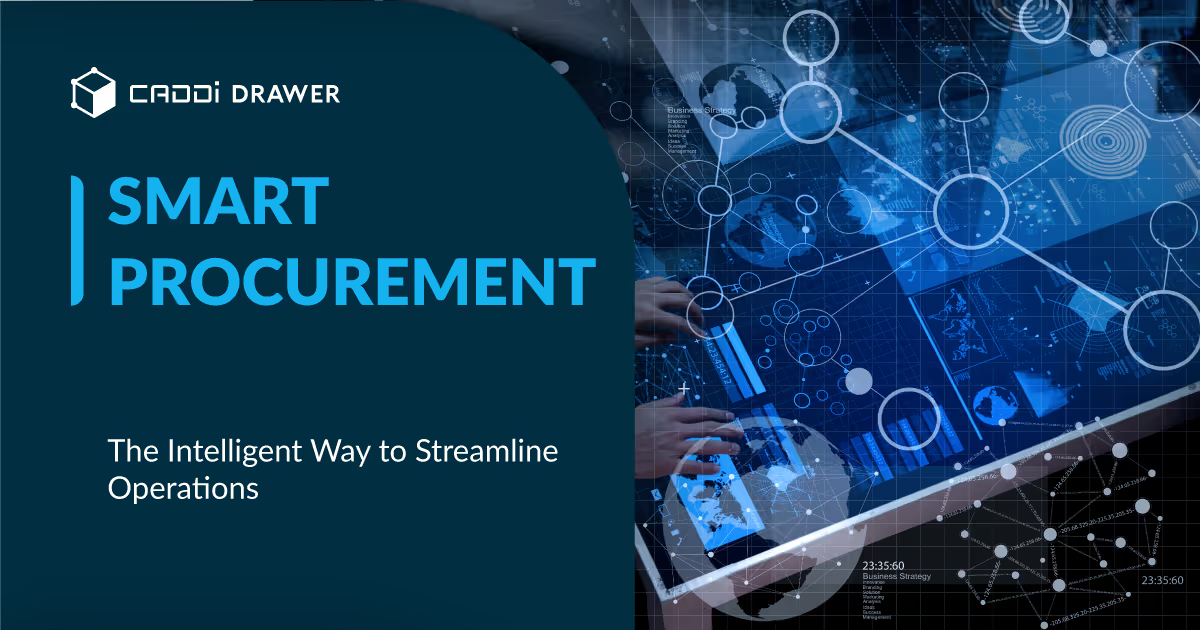







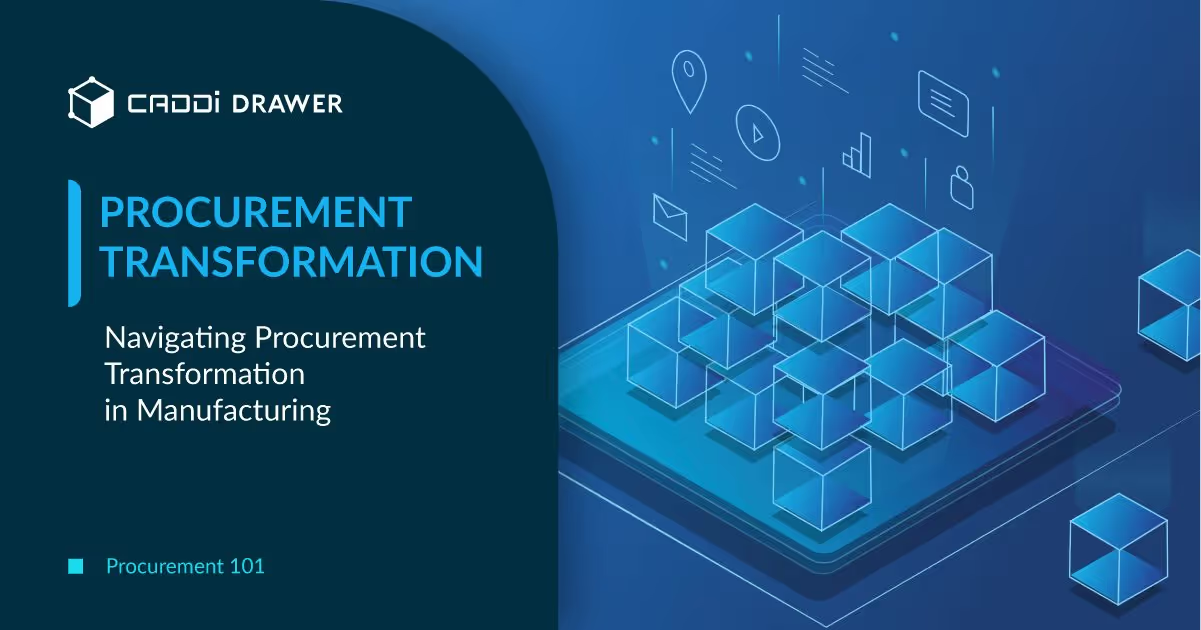

.svg)



.svg)
.svg)
.svg)


